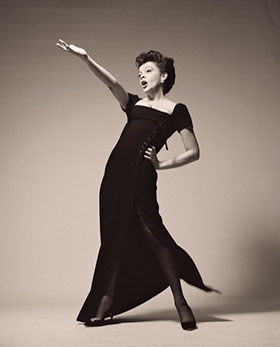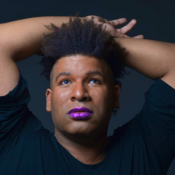All month long, Buddies is hosting a blog salon with some our favourite writers and artists responding to one question: How do I connect with my queer heritage? Follow the conversation on our blog, or join the conversation on Facebook and Twitter with the hashtag #GayHeritageProject. Here’s an entry from the always-amazing Ryan G. Hinds.
I grew up as one of those gays who was determined not be a stereotype. I remember consciously picking up a Judy Garland CD at Zellers in Mississauga (it was 1960’s That’s Entertainment ) and putting it back down. To my teenaged mind, being gay was fine but being the kind of gay who listens to Judy Garland was not. The kind of gay who listened to Judy Garland was old, tragically sad always, and painfully out of step with what was going in the world around him.
My conversion happened a scant 3 years later at age 21; on a flight, I selected her Carnegie Hall album to fall asleep to, assuming it would be a dull, plodding affair. By the time we landed, I got Judy Garland. I understood what she was singing about, I understood why she was a patron saint of gays, and I understood why I was afraid of diving into her ferocious oeuvre. I understood that Judy Garland represented a history I was avoiding.

Around the time I was rejecting music by legendary divas in suburban strip malls, I was also something of a club kid. Underage nights on dancefloors, friday nights on Electric Circus, and going to gay youth groups with the sole intent of finding people to party with occupied my weekends. Everything was about instant gratification and the immediacy of here and now, until Judy Garland came along and showed me what had happened in the past. Her work was a gateway drug into the work of some of the most important homosexuals, both male and female, that have ever worked in film and television and music and theatre: as a performer and as a gay-ling, our queer elders have given us sensibility, an aesthetic, and some sacred texts to learn from; in other words, our heritage.
As flowers beget seeds that beget flowers, so goes our heritage. Judy begat Liza begat Madonna begat Gaga. For better or for worse.
Of course, it’s one thing to learn abut music or movies and another thing entirely to learn about riots, protests, and awakenings….and the fact of the matter is that it was reading about Judy Garland when I first learned about Stonewall. The myth of Stonewall has always been more exciting than the lost to history details. People who say they were there debate whether or not others who say they were there actually were, and both sides argue about facts, details, and times with an impassioned ferocity that matches JFK conspiracy theorists.
What is an in-disputable fact is that Garland’s massively attended funeral (20,000 mourners, fans, admirers, and gawkers was the most conservative estimate, and the New York Times took care to mention the “large numbers of Negro women” present) was the afternoon of June 28,1969, and the Stonewall riots happened later that evening. Many people, including Sylvia Rivera, claimed not only to have been at both events but that the emotions of the funeral helped propelled them to fight. True or not, it makes for a great story…..and true or not, it’s the Garland connection that lead me to learn the various incredible events that make up what happened that night at the Stonewall Inn: stone butch dykes, drag queens, teenaged street trade, and queers of all stripes spilled their blood and had their bones broken while Judy Garland lay cold in her coffin a few miles away uptown.
Through the miracle/curse of modern technology, our queer heritage is never more than a mp3 or youtube hit away. Every 10 years or so, someone writes an article about how gays have no idea who Judy is anymore, and then Rufus Wainwright wins critical and audience acclaim recreating her concerts or Glee scores high ratings for episodes featuring Garland songs. Much as some people try to move on culturally, Wizard of Oz is still as much a part of the gay DNA as it ever was.
Stereotypes are stereotypes for a reason, so while many of us befriend Judy as a way of not dealing with “The Man That Got Away”, some of us cotton to the Judy who sang about glamorously gay urban centres like San Francisco and London, and who was certainly around in spirit form the night our queer revolution was launched. Every time I listen to a joyous, defiant song like “Swanee”, “Lose That Long Face”, “Get Happy” or “Almost Like Being Love” and look at the writers, choreographers, and designers Judy created those performances with, our queer history literally rings in my ears.

